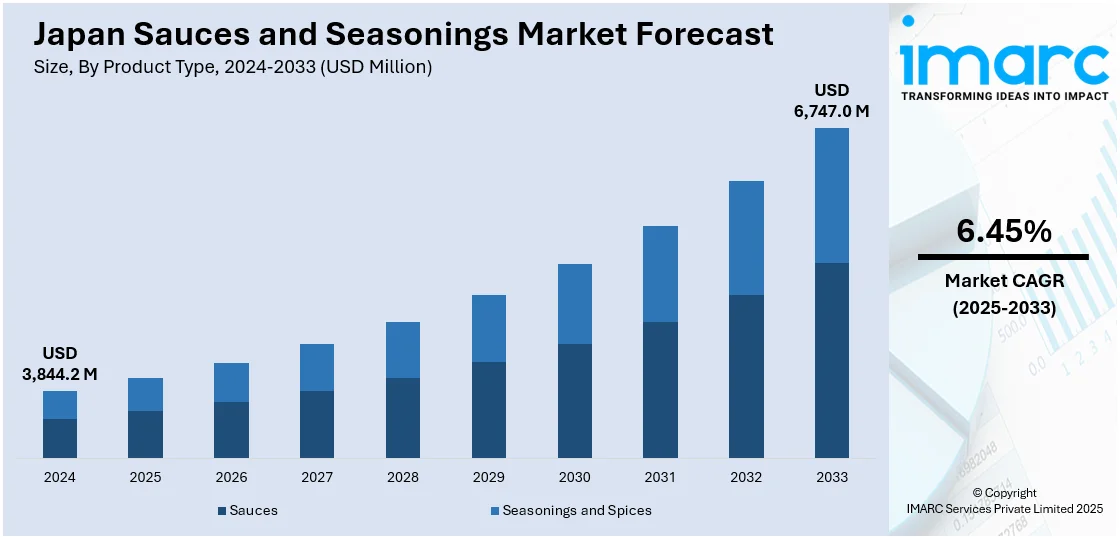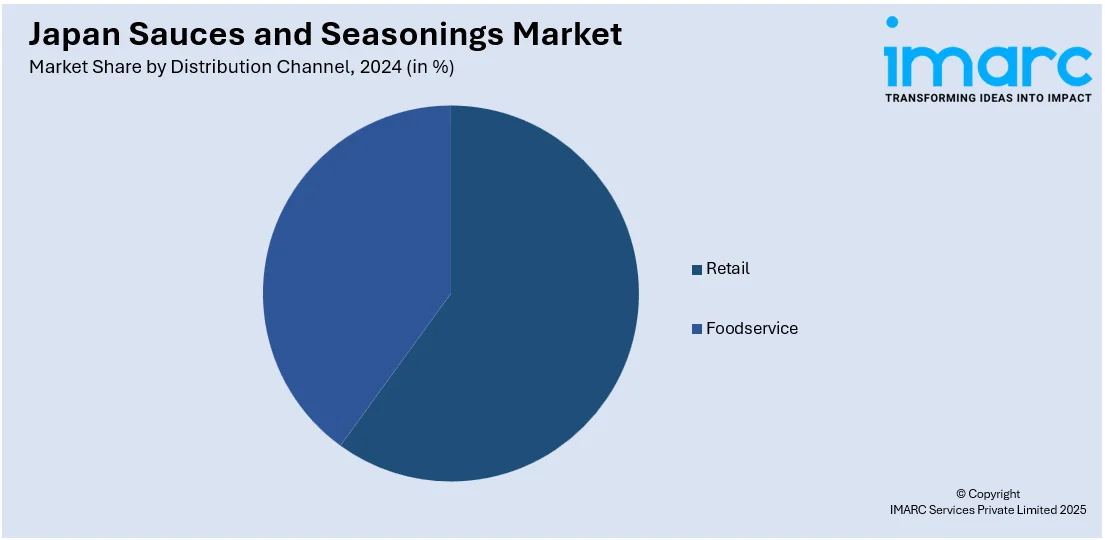
Japan Sauces and Seasonings Market Size, Share, Trends and Forecast by Product Type, Packaging Type, Distribution Channel, End User, and Region, 2025-2033
Japan Sauces and Seasonings Market Overview:
The Japan sauces and seasonings market size reached USD 3,844.2 Million in 2024. Looking forward, IMARC Group expects the market to reach USD 6,747.0 Million by 2033, exhibiting a growth rate (CAGR) of 6.45% during 2025-2033. The market is driven by rising health consciousness, increasing demand for low-sodium and organic products, and a growing preference for premium gourmet sauces. Additionally, an aging population, government health initiatives, globalization of cuisine, and expanding e-commerce accessibility are also propelling the market. Innovation in flavors and functional ingredients further fuels industry growth.
|
Report Attribute
|
Key Statistics
|
|---|---|
|
Base Year
|
2024 |
|
Forecast Years
|
2025-2033
|
|
Historical Years
|
2019-2024
|
| Market Size in 2024 | USD 3,844.2 Million |
| Market Forecast in 2033 | USD 6,747.0 Million |
| Market Growth Rate 2025-2033 | 6.45% |
Japan Sauces and Seasonings Market Trends:
Rising Demand for Health-Conscious and Low-Sodium Sauces & Seasonings
The growing demand for healthier, low-sodium, and organic products, driven by increasing health awareness among consumers, is favoring the Japan sauces and seasonings market growth. With Japan’s aging population and rising concerns about lifestyle-related diseases, many consumers are seeking reduced-salt soy sauce, sugar-free teriyaki sauces, and MSG-free seasonings. Japan's elderly population has reached 36.25 million, or 29.3% of the total population, the highest ratio globally among countries with populations over 100,000. One out of seven employees is now aged 65 or older, with this trend of aging affecting demand in different markets, such as sauces and seasonings. Numerous brands are accommodating tastes that are senior-friendly and health-conscious and providing smaller packaging sizes. With the declining population of Japan, innovation in key domains such as condiments becomes imperative to sustain home consumption. In addition, manufacturers are responding by launching products with natural ingredients, fortified with functional benefits including added vitamins or probiotics. Additionally, the popularity of gluten-free and plant-based seasonings is rising due to dietary preferences and allergies. Government initiatives promoting reduced salt intake are further creating a positive Japan sauces and seasonings market outlook. As a result, companies are innovating with fermentation techniques and alternative ingredients to maintain flavor while reducing unhealthy additives. This shift aligns with global wellness trends, positioning Japan as a key market for health-focused sauces and seasonings in the coming years.

Expansion of Premium and Gourmet Sauces in Retail and Foodservice
The market is experiencing a rise in premium and gourmet product offerings, catering to both home cooks and foodservice providers. Consumers are increasingly willing to pay more for high-quality, artisanal, and imported sauces, such as truffle-infused soy sauce, aged balsamic vinegar, and specialty miso pastes. This trend is fueled by the growing influence of global cuisine, celebrity chefs, and cooking shows that emphasize authentic flavors. Retailers are expanding their premium product lines, while restaurants and hotels are incorporating gourmet seasonings to enhance dining experiences. Additionally, limited-edition and regionally sourced sauces are gaining popularity as consumers seek unique and authentic tastes. The popularity of e-commerce platforms is further driving this trend by making specialty sauces more accessible. As disposable incomes rise and culinary curiosity grows, the demand for premium sauces and seasonings is expanding the Japan sauces and seasonings market share.
Japan Sauces and Seasonings Market Segmentation:
IMARC Group provides an analysis of the key trends in each segment of the market, along with forecasts at the country level for 2025-2033. Our report has categorized the market based on product type, packaging type, distribution channel, and end user.
Product Type Insights:
- Sauces
- Hot Sauces
- Table Sauces
- Cooking Sauces
- Dips and Dressings
- Seasonings and Spices
- Powdered Seasonings
- Liquid Seasonings
- Herb and Spice Blends
The report has provided a detailed breakup and analysis of the market based on the product type. This includes sauces (hot sauces, table sauces, cooking sauces, and dips and dressings), and seasonings and spices (powdered seasonings, liquid seasonings, and herb and spice blends).
Packaging Type Insights:
- Bottles and Jars
- Pouches and Sachets
- Cans and Tins
- Spray and Squeeze Packs
A detailed breakup and analysis of the market based on the packaging type have also been provided in the report. This includes bottles and jars, pouches and sachets, cans and tins, and spray and squeeze packs.
Distribution Channel Insights:

- Retail
- Foodservice
The report has provided a detailed breakup and analysis of the market based on the distribution channel. This includes retail and foodservice.
End User Insights:
- Household/Consumer
- Food manufacturers
- HoReCa (Hotels, Restaurants, Cafés)
A detailed breakup and analysis of the market based on the end user have also been provided in the report. This includes household/consumer, food manufacturers, and HoReCa (hotels, restaurants, cafés).
Regional Insights:
- Kanto Region
- Kansai/Kinki Region
- Central/ Chubu Region
- Kyushu-Okinawa Region
- Tohoku Region
- Chugoku Region
- Hokkaido Region
- Shikoku Region
The report has also provided a comprehensive analysis of all the major regional markets, which include Kanto Region, Kansai/Kinki Region, Central/ Chubu Region, Kyushu-Okinawa Region, Tohoku Region, Chugoku Region, Hokkaido Region, and Shikoku Region.
Competitive Landscape:
The market research report has also provided a comprehensive analysis of the competitive landscape. Competitive analysis such as market structure, key player positioning, top winning strategies, competitive dashboard, and company evaluation quadrant has been covered in the report. Also, detailed profiles of all major companies have been provided.
Japan Sauces and Seasonings Market News:
- June 12, 2024: Kikkoman, a Japanese manufacturer of traditionally brewed soy sauce, has initiated the construction of a USD 560 million production facility in Jefferson, Wisconsin, as part of its strategy to enhance global supply chains and meet increasing demand for soy sauce and related seasonings. This expansion aligns with Kikkoman's "Global Vision 2030," aiming to strengthen its presence in North America, the company's largest overseas market.
Japan Sauces and Seasonings Market Report Coverage:
| Report Features | Details |
|---|---|
| Base Year of the Analysis | 2024 |
| Historical Period | 2019-2024 |
| Forecast Period | 2025-2033 |
| Units | Million USD |
| Scope of the Report |
Exploration of Historical Trends and Market Outlook, Industry Catalysts and Challenges, Segment-Wise Historical and Future Market Assessment:
|
| Product Types Covered |
|
| Packaging Types Covered | Bottles and Jars, Pouches and Sachets, Cans and Tins, Spray and Squeeze Packs |
| Distribution Channels Covered | Retail, Foodservice |
| End Users Covered | Household/Consumer, Food manufacturers, HoReCa (Hotels, Restaurants, Cafés) |
| Regions Covered | Kanto Region, Kansai/Kinki Region, Central/ Chubu Region, Kyushu-Okinawa Region, Tohoku Region, Chugoku Region, Hokkaido Region, Shikoku Region |
| Customization Scope | 10% Free Customization |
| Post-Sale Analyst Support | 10-12 Weeks |
| Delivery Format | PDF and Excel through Email (We can also provide the editable version of the report in PPT/Word format on special request) |
Key Questions Answered in This Report:
- How has the Japan sauces and seasonings market performed so far and how will it perform in the coming years?
- What is the breakup of the Japan sauces and seasonings market on the basis of product type?
- What is the breakup of the Japan sauces and seasonings market on the basis of packaging type?
- What is the breakup of the Japan sauces and seasonings market on the basis of distribution channel?
- What is the breakup of the Japan sauces and seasonings market on the basis of end user?
- What is the breakup of the Japan sauces and seasonings market on the basis of region?
- What are the various stages in the value chain of the Japan sauces and seasonings market?
- What are the key driving factors and challenges in the Japan sauces and seasonings market?
- What is the structure of the Japan sauces and seasonings market and who are the key players?
- What is the degree of competition in the Japan sauces and seasonings market?
Key Benefits for Stakeholders:
- IMARC’s industry report offers a comprehensive quantitative analysis of various market segments, historical and current market trends, market forecasts, and dynamics of the Japan sauces and seasonings market from 2019-2033.
- The research report provides the latest information on the market drivers, challenges, and opportunities in the Japan sauces and seasonings market.
- Porter's five forces analysis assist stakeholders in assessing the impact of new entrants, competitive rivalry, supplier power, buyer power, and the threat of substitution. It helps stakeholders to analyze the level of competition within the Japan sauces and seasonings industry and its attractiveness.
- Competitive landscape allows stakeholders to understand their competitive environment and provides an insight into the current positions of key players in the market.
Need more help?
- Speak to our experienced analysts for insights on the current market scenarios.
- Include additional segments and countries to customize the report as per your requirement.
- Gain an unparalleled competitive advantage in your domain by understanding how to utilize the report and positively impacting your operations and revenue.
- For further assistance, please connect with our analysts.
 Request Customization
Request Customization
 Speak to an Analyst
Speak to an Analyst
 Request Brochure
Request Brochure
 Inquire Before Buying
Inquire Before Buying




.webp)




.webp)












